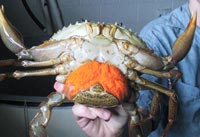

This key clotting agent is called Limulus amebocyte lysate (LAL), and it’s only found in the blood of horseshoe crabs. Blood-like hemolymph contains granular amebocyte cells, which cause the blood to gel quickly when exposed to certain bacteria and toxins.In an earlier episode of EarthDate, we briefly covered the primitive immune systems of horseshoe crabs and how they protect the body from harmful bacteria and toxins.That substance is essential for the testing of any medical material that comes in contact with our bloodstream, including vaccines, IVs, and implants. Synopsis: The primitive immune systems of horseshoe crabs have effectively protected them through the eons, and a unique extract derived from their blue blood also protects humans from potentially fatal toxins. Pick it up by its shell-never by its tail, which can harm it-put it back in the water, and thank it for its service to humans.

If you ever find a horseshoe crab on a beach, you can lend a hand. Scientists have responded by creating a synthetic substance similar to LAL, which is starting to replace the original, and with breeding programs to rebuild populations. This procedure, along with human beach encroachment and increased fishing pressure, is reducing horseshoe crab numbers worldwide. They drain about 30% of their blood and then release them. To get enough blood to produce the LAL, medical companies capture half a million horseshoe crabs each year when the creatures congregate for spawning. So they isolated the coagulating agent, called LAL, powdered it, and now use it to test every vaccine, intravenous drug, and medical implant for the presence of bacteria in every hospital and lab around the world today. It coagulates so rapidly and completely around invading pathogens, that medical researchers realized it could be used to detect pathogens for us too. Horseshoe crab blood is copper based, not iron based like ours, which makes it blue. In the last 40 years, it’s become a vital player in our medical industry. In another episode, we talked about the horseshoe crab, which has existed on Earth nearly unchanged for more than 400 million years.
BLUE CRAB EGGS FREE
This substance is key for medical manufacturers to ensure injectable medicines such as vaccines are free of contaminants. On the Coast: Blue crabs are common in Georgia’s coastal waters and brightly-colored, floating crab pot buoys can be seen along most waterways.Horseshoe crabs are bled to harvest a key substance found in their hemolymph, a blue blood-like substance, with amazing immune properties. Chesapeake Bay, North Carolina, and Louisiana support the largest blue crab fisheries. Interesting Facts: The blue crab’s scientific name, Callinectes sapidus, translates to “savory beautiful swimmer.” Blue crabs almost always walk sideways, clearing a path with their sharp lateral spines, but when they swim they use their paddle-like rear legs for propulsion. Predators: Fish, sharks, rays, and sea turtles.Ĭonservation Status: No legal status but loss of habitat combined with the blue crab’s popularity as a food for humans may lead to reduced populations. Female crabs store sperm and will use it to fertilize multiple spawnings.

The eggs hatch into planktonic larva and migrate back nearshore into estuaries. One female may carry as many as eight million eggs. Two to nine months later the female migrates offshore to release her eggs. Male holds onto a female until her final molt, after which they mate. Size: Can reach nine inches in carapace (shell) width.įood: Bivalves, crustaceans, fish, worms, plants, detritus, and dead fish and plants.īreeding: Mate in brackish water from February to November. Habitat: Nearshore, including beaches, marshes, bays, and estuaries.ĭescription: A large swimming crab with a gray/green or gray/blue carapace and large, blue claws, which are tipped with red in the female. Range/Geographical Distribution: Along the coast from Massachusetts to Uruguay.


 0 kommentar(er)
0 kommentar(er)
